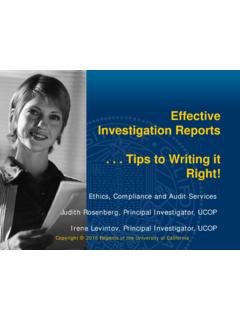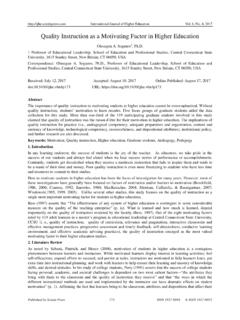Transcription of Video Gaming as a Factor that Affects Academic Performance ...
1 Video Gaming as a Factor that Affects Academic Performance in Grade Nine 2018 Marion Terry, Amjad Malik, Brandon University University College of the North Canada Canada Keywords: Video games, adolescence, teenagers, Academic Performance , school Performance , school grades, school attendance 1 Video Gaming as a Factor that Affects Academic Performance in Grade Nine Marion Terry, Amjad Malik, Brandon University University College of the North Canada Canada Abstract In an attempt to investigate concerns expressed by high school counselors, the researchers developed a quantitative Likert-scale survey to assess the relationship between recreational Video Gaming and Academic Performance (defined as school attendance and final grades) in grade 9. Questions about Video Gaming appeared with other questions about social relations, extra-curricular activities, and leisure-time activities. Complete data sets resulted for 82 of the 96 grade nine students in three mid-western Canadian high schools who volunteered for the study with their parents permission.
2 The students answered the survey questions in their school libraries during release time from their English Language Arts classes. This article reports gender-separated correlations between Video Gaming and Academic Performance , based on the students questionnaire responses, attendance records, and the arithmetic means of their final marks in English, mathematics, science, and social studies. Pearson product-moment correlations were determined for linear data and Spearman rho correlations were determined for nonlinear data both with calculations of two-tailed probability of error. In this report, the results are collated into 8 overall categories created by correlating 42 pairs of variables related to the following factors : attendance, final marks, time spent playing Video games, positive and negative school experiences, and positive and negative Video game experiences. In consideration of their findings, the researchers recommend that school professionals advise parents and students of the potentially harmful effects of playing Video games.
3 The article contains 8 tables with two sections each (for male and female participants), and 47 cited entries in the list references. Keywords: Video games, adolescence, teenagers, Academic Performance , school Performance , school grades, school attendance Our study responds to school counselors concerns over increases in the problematic effects of recreational Video Gaming on their students school attendance and grades. These counselors wanted to make data-driven decisions to advise parents to monitor their children s Video Gaming activities. At the same time, we chose to study the correlations between school Performance and other factors , primarily as a means to embed our Video Gaming questions into these other categories. We were afraid that our grade 9 research participants would otherwise construe our focus on Video Gaming and therefore might not be as honest in their answers. Our research purpose was therefore to study the correlations between a variety of factors and Academic Performance in grade 9.
4 The factors included social relations ( , friends), extra-curricular activities ( , work), and leisure-time activities ( , playing Video games). We operationally defined Academic Performance as school attendance and final marks. Because we collected the data by means of a Likert-scale questionnaire, and because we developed our own survey instrument, we did not anticipate collecting statistically significant findings. We were essentially testing the waters to see whether any correlations would arise. 2 Our results show correlations that warrant further investigation and confirm our school counselors concerns over the relationship between recreational Video Gaming and Academic Performance . Interested readers are invited to contact the primary author of this article for copies of the survey instrument and our aggregate data. We also welcome inquiries about the other correlations that we discovered, related to the other factors that were included in our survey.
5 Overview of Related Literature We began our research as an investigation of the relationships between adolescent Video Gaming and two aspects of school Performance : attendance and school marks. Therefore, although we later expanded our inquiry to include other factors that affect Academic Performance in grade 9, the following overview is limited to the literature on Video Gaming . Because we separated our own data by gender, our literature overview includes gender-related observations whenever relevant. The potential of Video Gaming to influence students lives is undisputed. Whether recreational or educational (Brockmyer et al, 2009; Chuang & Chen, 2009; Lee & LaRose, 2007), violent or nonviolent (Ferguson & Kilburn, 2010; Fleming & Rickwood, 2001; Huesmann, 2010), Video Gaming has become an integral part of North American children s lives outside of school. Over 90% of all youth in the United States play Video games (Hagedorn & Young, 2011, Gaming Addiction, para.)
6 1). The literature on the relationship between Video Gaming and school attendance is sparse. We found only one report of research that specified Gaming as a predictor of truancy (Rehbein, Kleimann, & Moble, 2010). In their study of 15,168 German 9th graders, Rehbein et al. (2010) identified increased truancy as directly related to Video game dependency (VGD), which they clearly differentiated from extensive Gaming . Austin and Totaro (2011) included Video Gaming as one of many internet activities that could affect school attendance, but they reported no correlation between Gaming per se and attendance. The girls in their study tended to skip school to socialize on the internet. The boys were more prone to Video Gaming , but during out-of-school hours. These findings are important, because other researchers (such as Lin & Chen, 2006; and Yakovlev & Kinney, 2008) have found clear relationships between attendance and school marks. Yakovlev and Kinney, for example, reported an overall course grade decrease of points for every class missed.
7 Much more research has been done to investigate the connection between Video Gaming and school Performance . Most researchers have reported negative correlations, based on time spent Gaming , game content, and levels of player dependency. Clear and negative correlations have been found between the amount of time that a student spends playing Video games and his/her school marks (Gentile, Lynch, Linder, & Walsh, 2004; Hastings et al., 2009; Sharif & Sargent, 2006). In their study of 1,492 high school students in Thailand, Jaruratanasirikul, Wongwaitaweewong, & Sangsupawanich (2009) found that 2 hours of Gaming per day correlated with an overall GPA of below Violent Video game content, which is characteristic of massive multiplayer online role-playing games (Oggins & Sammis, 2012; Sublette & Mullan, 2012; Young, 2009), also negatively correlates with Academic Performance (Alsaleh, 2005; Lynch, Gentile, Olson, & van Brederode, 2001; Sharif & Sargent, 2007). Most damaging of all is Video game dependency (VGD, Rehbein et al.)
8 , 2010), which has also been described as pathological Gaming (Gentile, 2009) and addiction (Charlton & Danforth, 2007; 3 Shao-I, Jie-Zhi, & Der-Hsiang, 2004; Van Rooij, Schoenmakers, Vermulst, Van Den Eijnden, & Van De Mheen, 2011). The negative correlations that have been found between Video Gaming and overall school Performance are augmented by reports of other school-related skills and behaviors. Monke (2009) purported that the increased distances of time and space afforded by worldwide online games would interfere with students developing normal perceptions of time and space. Anand (2007) found that Video game addicts tended to fall asleep in class and fall behind in their assignments. Gentile (2009) reported correlations between pathological Gaming and attention deficits in class. Griffiths (2010a) and Sharif and Sargent (2006) found that Video Gaming creates time conflicts that reduce the amount of time that gamers devote to homework. The 425 (10-19-year-old) boy gamers in Cummings and Vandewater s (2007) study spent an average of 30% less time reading for every hour that they played Video games on weekdays, and the 109 girls spent an average of 34% less time doing homework for every hour that they played Video games on weekdays.
9 Clearly, there is evidence in the literature that Video Gaming correlates with diminished school Performance . Classroom behaviors are affected by the relationship between adolescent Video Gaming and aggression (Barenthin & Van Puymbroeck, 2006; Ferguson & Kilburn, 2010; Hastings et al., 2009). This aggression makes players more apt to argue with teachers and fight with classmates (Alsaleh, 2005; Gentile et al., 2004; Lynch et al. 2001). The level of aggression correlates with the degree of violence in the games (Anderson, Gentile, & Buckley, 2007; Anderson, Shibuya, & Ihori, 2010; Huesmann, 2010). Players of violent games are rewarded for becoming increasingly engaged in the violence (Bartlett & Rodeheffer, 2009; Ledwis et al., 2008, Fleming & Rickwood, 2001). Outside of the Gaming environment, this aggression manifests as emotions that range from irritability (Alsaleh, 2005, Hagedorn & Young, 2011) to outright hostility (Gentile et al., 2004, Lynch et al.)
10 , 2001; Shao-I et al., 2004) and loss of control (Duven, Muller, & Wolfling, 2011; Hagedorn & Young, 2011). In other research, Video Gaming has been found to benefit school marks, skills, and behaviors (Barber, Eccles, & Stone, 2001; Blum-Dimaya, Reeve, Reeve, & Hoch, 2010; Sutherland, Facer, Furlong, & Furlong, 2000). While Ferguson (2011) conservatively concluded that Gaming does not necessarily jeopardize school Performance , other researchers have found positive correlations between Gaming and educational development, including reading and math (Bowers & Berland, 2013; Wittwer & Senkbeil, 2008), cognitive processing (Abrams, 2009; Ferguson, 2007); imagination and creativity (Durkin & Barber, 2002; Steinkuehler & Duncan, 2008), nonverbal intelligence (Subrahmanyam, Greenfield, Kraut, & Gross, 2001), and general literacy and learning skills (Gee, 2004; Jenkins, 2006). Bowers & Berland (2013) found positive correlations between 1-2 hours of daily Gaming and mathematics and reading skills in 13,960 US high school students.


















